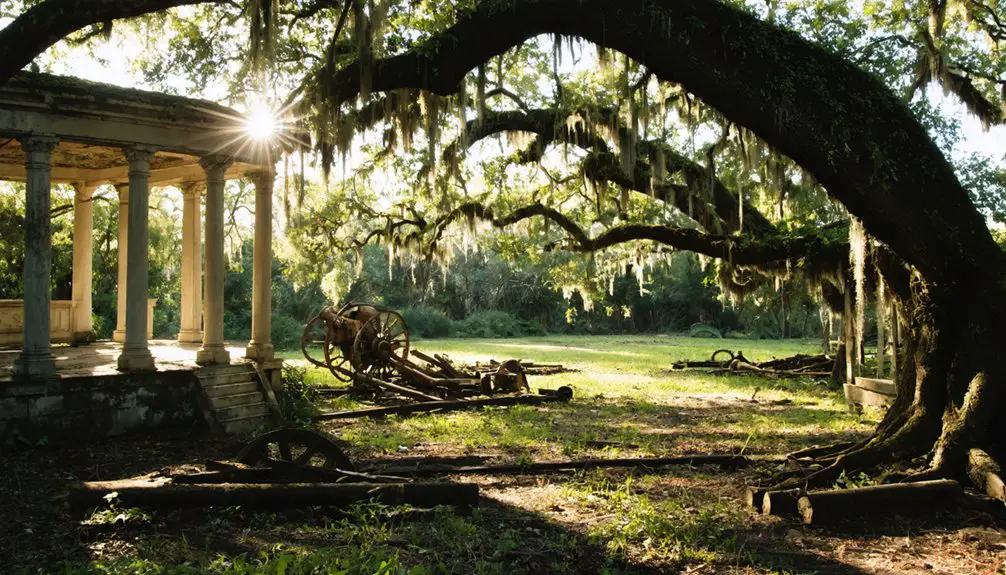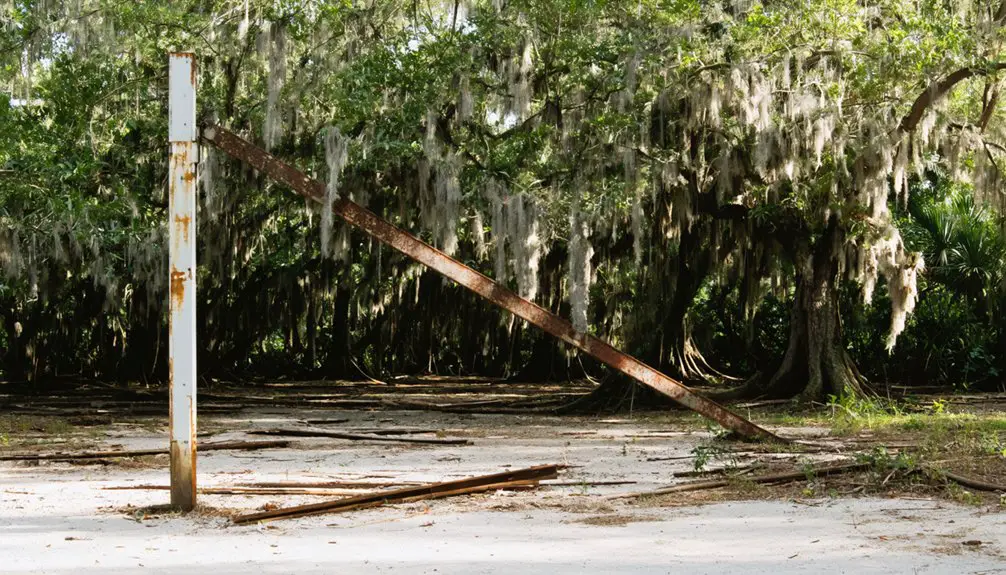You’ll find Villa City’s haunting remains near Lake Emma in Lake County, Florida, where George Thomas King’s 1885 vision of a citrus paradise once flourished. The settlement boasted 35 homes, a hotel, church, and post office until Florida’s Great Freeze of 1894-1895 struck. When temperatures plunged to 12 degrees, destroying crops and bursting trees, residents abandoned their dreams. Today, scattered ruins and old rail tracks tell a deeper story of pioneer ambition and nature’s power.
Key Takeaways
- Villa City was a thriving Florida citrus settlement established in 1885 by George Thomas King near Lake Emma.
- The community peaked in the early 1890s with 150 residents, 35 homes, a church, school, hotel, and post office.
- The Great Freeze of 1894-1895 destroyed citrus crops and caused property values to plummet from $1,000 to pennies per acre.
- Most residents abandoned Villa City after the freeze, leaving buildings to decay and be stripped for materials.
- Today, only scattered ruins and a state historical marker remain to commemorate Villa City’s brief but vibrant existence.
The Birth of a Citrus Paradise (1885)
When George Thomas King arrived from Massachusetts in 1885, he envisioned transforming the pristine lands near Lake Emma into a thriving citrus settlement.
Through his leadership, Villa City quickly emerged as a beacon of agricultural innovation in Lake County, Florida. Similar to how Ed Tison pioneered the Marsh Seedless Grapefruit in other parts of Florida during this era, Villa City was poised to make its own mark on citrus cultivation.
You’d have found King’s estate at the heart of the community, showcasing the region’s boundless potential. He established key amenities including a general store and hotel, making Villa City an attractive destination for northern settlers.
Early Years of Growth and Prosperity
As Villa City blossomed through the late 1880s and early 1890s, you’d have witnessed a remarkable transformation of the former wilderness into a vibrant settlement.
At its heart stood George Thomas King’s impressive estate, featuring four fireplaces, ornate gardens, and lotus-filled ponds fed by windmill-powered fountains.
The community’s development accelerated as northern investors, drawn by the promise of citrus cultivation, purchased combined residential and agricultural lots. The Methodist Episcopal Church built in 1888 became a central gathering place for residents of all denominations.
You’d have found a bustling town with about 35 homes, complete with a post office, school, church, hotel, and even a photographic studio. The railroad expansion of the late 19th century helped fuel the town’s growth and commerce.
Economic diversification flourished through kaolin mining operations and Archibald Gano’s sawmill, while plans for steamship travel along Palatlakaha Creek promised to connect Villa City to broader trade networks.
The Devastating Freeze of 1894-1895
Villa City’s vibrant citrus operations came to an abrupt halt when Florida’s Great Freeze struck in December 1894, with temperatures plunging well below freezing and destroying much of the season’s fruit still on the trees. Land values experienced a devastating crash, dropping from a thousand dollars per acre to just pennies on the dollar.
You wouldn’t have wanted to be there on that bitter February night in 1895 when the second freeze hit, causing stored barrels of orange oil to explode in the processing plant and sending flames through the town’s industrial heart.
The combination of the devastating freezes and the destructive fire proved too much for Villa City to overcome, leading most residents to abandon their groves and the once-prosperous community. Many farmers and their families joined a massive exodus from the state, seeking new opportunities elsewhere.
Before The Freeze
Prior to the devastating freeze of 1894-1895, the bustling community of Villa City thrived as one of Lake County’s most promising settlements.
You’d have found a vibrant town where Native American history merged with pioneering spirit, as evidenced by ancient mounds near the river where George Thomas King recognized the area’s agricultural potential. The fertile soil, spring-fed lakes, and subtropical climate supported thriving citrus groves, while Archibald Gano’s sawmill powered early settlements with lumber along Palatlakaha Creek. Located in Lake County, Florida, the town represented a prime example of early development in the region.
The community infrastructure grew to include a post office, school, church, hotel, and roughly 35 homes. A talented photographer even operated a photographic studio in the town. Environmental resources fueled diverse industries from citrus farming to kaolin mining, while King’s grand estate showcased the town’s prosperity with its elaborate gardens, fountains, and windmill-fed water system.
Night of The Explosion
When the first freeze struck Villa City on December 29, 1894, few residents could have predicted the catastrophic events that would unfold over the next six weeks.
You’d have witnessed temperatures plummet into the teens as rain turned to frost, leaving citrus trees damaged but alive.
January’s deceptive warmth brought false hope as temperatures climbed back to the 80s. Trees filled with new sap, making them vulnerable to what came next.
On February 7, the killing freeze arrived. As temperatures plunged to 12 degrees, you’d have seen rare snow falling while hearing the explosive sounds of trees literally bursting from within. Like the historic St. Johns River freeze of 1835, the devastation was unprecedented.
The community’s resilience was tested as frozen sap expanded, splitting bark and destroying centuries of agricultural investment.
In the explosion’s aftermath, Villa City’s once-thriving groves lay in ruins, forever changing the town’s destiny. The devastation led to 21,737 acres of citrus groves reporting zero production that year.
Town’s Fatal Collapse
The devastating impact of the Great Freeze rippled far beyond shattered tree trunks and frozen fruit. You’d have witnessed Villa City’s agricultural decline unfold in two brutal acts – first when December’s surprise freeze stripped the trees bare, then February’s arctic blast that sent temperatures plummeting to 12°F with rare Florida snow.
The killing freeze split bark and crystallized sap, destroying thousands of acres of citrus.
What followed was a massive economic restructuring. Land values crashed from $1,000 to just $10 per acre. You’d have seen your neighbors abandon their groves as small farmers went bust. The wealthy consolidated power while others fled south, forever changing Florida’s citrus geography.
Villa City never recovered, transforming from a prosperous agricultural hub into a ghost town within a single devastating winter.
Mass Exodus and Abandonment

After the devastating freeze of 1894-1895, you’d have witnessed Villa City’s population of 150 rapidly dwindle to just a handful of determined residents.
The mass departure included numerous families heading north, with the prominent King family returning to Massachusetts, symbolizing a pivotal loss of community leadership.
As abandoned properties fell into tax delinquency, you’d have seen local authorities seize vacant homes, while remaining residents salvaged materials and moved into the deserted structures.
The Great Migration North
During Florida’s Great Migration period from 1910 to 1970, Villa City experienced the same dramatic exodus of African American residents that affected much of the South.
You’ll find that migration patterns led thousands of Black residents to leave the area, following rail lines through Jacksonville’s transportation hub toward promising opportunities in northern cities.
The stark contrast between southern agricultural wages of less than $1 per day and northern industrial offers of $6-7 daily propelled this mass departure.
You won’t be surprised that the Pennsylvania and New York Central Railroads actively recruited from Jacksonville, offering free transportation and better-paying jobs.
The combination of Jim Crow laws, agricultural decline from the boll weevil crisis, and systematic disenfranchisement made the decision to leave an obvious choice for many African American families seeking economic and social freedom.
Vacant Homes Tax Seizure
Following the catastrophic Big Freeze of 1894-1895, Villa City’s rapid transformation into a ghost town triggered widespread property abandonment and subsequent tax seizures.
As residents fled north or to neighboring communities, they left behind their homes and defaulted on property taxes, unable or unwilling to maintain ownership of their devastated investments.
The state’s response was swift and methodical. They seized countless properties for delinquent taxes, taking possession of once-prosperous homesteads.
You’d have witnessed an interesting phenomenon in the aftermath – local opportunists moving into vacant houses, claiming abandoned possessions, and eventually dismantling the structures for lumber.
This informal redistribution of property continued until most buildings were stripped bare, their materials repurposed for construction projects in nearby areas.
Last Traces of Villa City’s Glory
Today, the remnants of Villa City stand as a fading indication to its former existence, with severe weathering and natural reclamation steadily erasing its physical traces.
You’ll find scattered debris and crumbling foundations where homes and businesses once thrived, as urban decay takes its inevitable toll. Nature’s persistent advance has transformed the landscape, with native Florida vegetation reclaiming the cleared lands and old roadways.
The cultural heritage of this forgotten town lives on through fragments of early 20th-century household items and weathered signage discovered among the ruins.
While local historians occasionally document what remains, there’s little organized preservation of Villa City’s material legacy. You might spot old rail track segments or machinery parts that hint at the town’s once-bustling economic life, but these remnants continue to fade with each passing season.
Legacy and Historical Significance

Villa City’s enduring legacy stretches far beyond its brief existence as a thriving citrus community in Lake County, Florida.
The town’s story of cultural resilience and agricultural adaptation continues to resonate with modern audiences, serving as a powerful reminder of nature’s impact on human settlements.
When you explore Villa City’s historical significance, you’ll discover:
- A reflection of pioneer spirit through the community’s response to the devastating freeze of 1894-95
- Evidence of economic flexibility as survivors shifted from citrus to turpentine production
- Lessons in community bonds that helped remaining residents weather unprecedented hardship
The state historical marker at the former King estate guarantees that Villa City’s tale of boom and bust won’t be forgotten, preserving essential insights into Florida’s agricultural heritage and settlement patterns.
Frequently Asked Questions
Were Any Artifacts or Personal Belongings Recovered From Villa City’s Abandoned Homes?
You’ll find scattered historical artifacts and abandoned belongings around crumbling foundations, though limited specific records exist of recovered items beyond structural remains, sawmill pieces, and household remnants left behind.
Did Any Other Florida Ghost Towns Emerge From the Same 1894-1895 Freeze?
You’ll find several Florida ghost towns emerged from those devastating freezes, including Astor, Earnestville, and Kerr City. Their citrus industries collapsed under historically extreme weather patterns during 1894-1895.
What Happened to Villa City’s Cemetery and Burial Records?
You won’t find detailed cemetery history or burial practices for Villa City, as most records were lost when residents fled. Any burial sites and documentation likely scattered during the town’s rapid abandonment.
Are There Any Surviving Photographs of Villa City Before Its Abandonment?
Ever wonder about lost moments in time? While a photography studio existed in Villa City by 1895, you won’t find any confirmed surviving photographs, though historical preservation efforts suggest some photographic evidence may exist in private collections.
Did Anne Parlow’s Descendants Continue Living in the Lake County Area?
You won’t find clear records of the Parlow family’s continued presence in Lake County after Villa City’s decline. Historical documents don’t definitively track Anne Parlow’s descendants in the area.
References
- http://franmuse.com/lake/1pages/vanished/villacity/villacityvanished.html
- https://en.wikipedia.org/wiki/Villa_City
- https://www.grovelandhistory.org/2021/12/VillaCity.html
- https://dbpedia.org/page/Villa_City
- https://www.southlakechamber-fl.com/history
- https://www.lakelandgov.net/departments/library/lakeland-history-room/brief-history-of-lakeland/
- https://digitalcommons.unf.edu/historical_architecture_main/4411/
- https://www.floridafiles.com/post/the-great-freeze-of-1894-1895-the-event-that-reshaped-florida-s-citrus-industry
- https://patch.com/florida/newportrichey/the-great-freeze-of-1894-1895
- https://www.thehistorycenter.org/the-big-chill/



